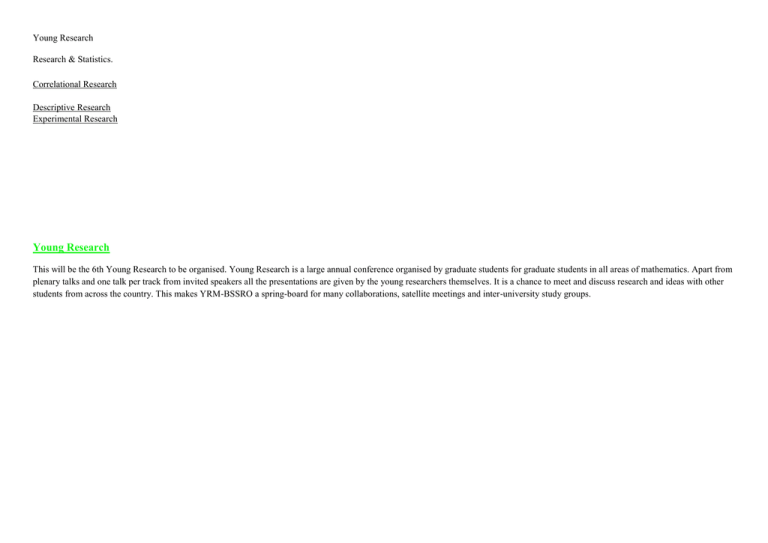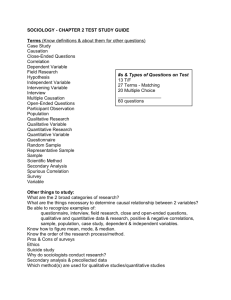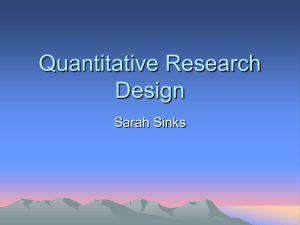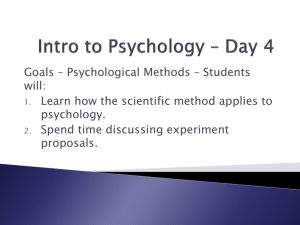Young Research
advertisement

Young Research Research & Statistics. Correlational Research Descriptive Research Experimental Research Young Research This will be the 6th Young Research to be organised. Young Research is a large annual conference organised by graduate students for graduate students in all areas of mathematics. Apart from plenary talks and one talk per track from invited speakers all the presentations are given by the young researchers themselves. It is a chance to meet and discuss research and ideas with other students from across the country. This makes YRM-BSSRO a spring-board for many collaborations, satellite meetings and inter-university study groups. Objectives of Research Motivations to verify and test important facts to analyse an event or process or phenomenon to identify the cause and effect relationship to develop new scientific tools, concepts and theories to solve and understand scientific and non scientific problems to find solutions to scientific, non scientific and social problems and to overcome or solve the problems occurring in our everyday life. to get a research degree (Doctor of Philosophy (Ph.D.)) along with its benefits like better employment, promotion, increment in salary, etc. to get a research degree and then to get a teaching position in a college or university or become a scientist in a research institution to get a knowledge of Research Grants and how to write Research Grant Proposals to get a research position in countries like India , U.S.A., Canada, Germany, England, Japan, Australia, etc. curiosity to find new things Key Learnings Article Writing Essay Research Paper Book Review Laboratory Research Marketing Research Legislative Drafting Thesis; Dissertation Book Citation Methods and Styles Research Grant Proposals Young research talent in focus under the BSSRO scheme Researchers aged 10 TO 35 or younger who are currently conducting independent research of high scientific quality may apply for funding under the new category “Young Research Talent”. The FRIPRO scheme’s funding announcement for 2016 will have a greater focus on scientific renewal in research projects and willingness to “think outside the box”. BSSRO , main instrument for funding researcher-initiated basic research – is being revamped in key ways, including greater focus on young talent, creative thinking and scientific renewal. Specific guidelines regarding who can apply for funding and how grant applications will be assessed are currently being drawn up. Better opportunities for younger researchers “The new white paper on research presented recently clearly signalled that the Government will work to make research a more attractive career choice for younger, highly skilled researchers. The Research Council for BSSRO is following it up by introducing a separate category for young talent under the BSSRO scheme.“This new category represents a separate arena where younger researchers will compete with each other, not against senior researchers with a long list of merits.” The BSSRO scheme will promote: research of internationally leading scientific quality; pioneering and innovative research; ' careers for talented younger researchers. more innovative thinking.Scientific quality has always been and will continue to be the decisive criterion for awarding funding under the BSSRO scheme. What is new is that the scheme encourages researchers in all of the categories to “think outside the box”. The extent of creative thinking and scientific renewal of a project will be assessed in relation to whether the proposed research exhibits: major potential for groundbreaking results and scientific renewal; creativity and unconventional approaches; renewal of theory and methodology; a major impact for a variety of disciplines and subject areas. The university and specialised university institutions have a considerably higher level of R&D activity than the university colleges. Moreover, the university and specialised university institutions have been given special responsibility for long-term basic research and researcher training. THE INDEPENDENT INSTITUTE SECTOR: The institute sector accounts for about 25 per cent Norway's R&D expenditures, which is somewhat less than the higher education sector. The sector encompasses about 130 institutions, differing according to size, field and degree of R&D. Of these, approximately 60 are institutes with research as their primary focus. These research institutes account for some 60 per cent of the sector's R&D activities. The remaining research is carried out at public administrative agencies, museums and archives, health institutions, etc. The Research Council has a special strategic responsibility for the research institutes receiving public basic funding. The Research Council also gives advice on the framework and objectives for various forms of regulations and funding with a view to promoting a cohesive policy for the whole institute sector. The Research Council prepares annual reports on the activities of the research institutes on commission from the responsible ministries. Key types of programmes Basic research programmes Basic research programmes are designed to promote scientific knowledge and expertise within designated priority areas of research. Basic research programmes are initiated by the Research Council, and their professional substance is planned in close cooperation with relevant research communities and with users of the project findings, when appropriate. The programme committee is usually comprised of researchers. Policy-oriented programmes Policy-oriented programmes are primarily designed for the public sector as well as industrial and special interest organisations. This type of programme is used to provide a better knowledge base for political decision-making as well as for planning at various levels of the public administration. Users and researchers work together to define the substance of the programme. User-directed innovation programmes User-directed innovation programmes are designed specifically for companies seeking further innovation of their activities or industries. These programmes comprise the Research Council's main instrument for achieving its industry-oriented R&D objectives. Users are responsible for establishing the basis for research, while the Research Council helps to create an arena for cooperation between the companies and the research community as regards the initiation, planning and implementation of research activities. Projects require at least 50 per cent co-financing from private enterprise. User-directed research seeks to promote R&D initiatives in industrial circles, and thus serves to enhance the focus on R&D within trade and industry as a whole. Independent projects are the Research Council's key funding instrument for independent, researcher-initiated basic research that is not associated with any specific research programme or infrastructure measure. Independent projects may also be initiated by users. Research & Statistics. Research Tips and Tools: Does the thought of writing a research paper cause anxiety? For many, creating a thesis statement, research, surveys and interviews can feel overwhelming to the point of complete panic! If you feel this way, do not procrastinate, start early and incorporate the tips referenced below into your process, you may find your anxiety turning into confidence and reassurance. Research: Take some time to familiarize yourself with the libraries you'll be using. Do not be timid-- talk to one of the reference librarians about where and how to start—they are there to help. To stress again, start early so you have plenty of time to work with a librarian. If you're under deadline, they may not have time to help you. Getting Started APA Style, Writing, and Publication Tips Research Methodology: The Objective of this course to pay attention to the most important dimension of Research i.e. Research Methodology. It will enable the Researchers to develop the most appropriate methodology for their Research Studies. The mission of the course is to impart research skills to the beginners and help improve the quality of Research by the existing researchers. The Course Structure is designed in a way that the learning of Research Methodology can move from Mugging up syndrome to fun-practical method; from a teaching process to an experimental process, from memorizing to brainstorming, from clearing the examination to feedback learning, from knowledge transfer to knowledge creation, from competitive learning to collaborative learning. The Participants of the Course will start the course by reading the provided literature at the end of the course they will find themselves equipped enough to author a book or two themselves. The way you approach your question will have a profound effect upon the way you construct your dissertation, so this section discusses the types of research you might undertake for your dissertation. The use of literature and case studies is considered and the merits of primary research are debated and advice is given on the use of existing research data. You may not be fond of statistics, but the potential relevance of a quantitative approach should be considered and similarly, the idea of qualitative analysis and conducting your own research may yield valuable data. The possibilities of using quantitative and qualitative data are also discussed. What approach should I take - qualitative or quantitative? Your approach, research design, and research question are all connected. 'Approach' means something more than the type of data you use – it refers to your overall orientation to research and the type of claims you will make for your study. Dissertations can be based on either quantitative or qualitative data, or on a combination of both. How you choose this may depend on your preferences and abilities, and the suitability of particular approaches to your topic. You need to be able to justify why you have chosen to use such data. Quantitative data is particularly useful when you wish to discover how common particular forms of behaviour such as illegal drug use are for a particular age group. Qualitative data is particularly useful when you wish to find out why people engage in such behaviour. Think about the Research Methods modules you have taken so far. Think about the different kinds of studies you have read for other modules. There is plenty of scope to use the approaches and methods that you are most comfortable with. You need to justify your approach and methods and to cite appropriate literature to help you do this. What if I want to record people's views on an issue, and give them a 'voice'? You will probably want to use in-depth qualitative data, and you may wish to adopt a realist, a phenomenologist, or a constructionist approach to the topic. Qualitative dissertations will include descriptive material, usually extracts from interviews, conversations, documents or field notes, and are therefore likely to be nearer to the upper limit of your word range (e.g. 8,000 words). The types of method suitable for a dissertation could include content analysis, a small scale ethnographic study, small scale in-depth qualitative interviewing. Whether you choose qualitative or quantitative analysis will depend on several things: Your preferred philosophical approach (realist, phenomenologist or constructionist). Your skills and abilities with methods of data collection (if needed) and analysis. The topic or issue you are interested in. How you frame your research question. Can I combine qualitative and quantitative methods? There are many ways in which qualitative and quantitative data and analysis can be combined. Here are two examples. You may be interested in doing an analysis that is primarily quantitative, looking at social trends, or policy implications. However you also want to introduce a 'human touch' by conducting one or several interviews asking what these trends mean to people or how particular individuals experience events. After doing your quantitative analysis, you should include a chapter or section on the qualitative data you have collected. In your discussion of findings you can use the qualitative data to help you understand the patterns in the quantitative analysis. You may be interested in doing an evaluative case study of a process or policy. You will have a particular focus – a 'case' that you are looking at. You will triangulate methods – i.e. collect data in several different ways, and some of these data may be quantitative. You will analyse each type of data and describe this, and then write a discussion that shows how each piece of analysis contributes to the overall picture of what is going on. General Resources Survey Research Measurement and Testing Research Ethics and Institutional Review: General Resources Ethical Codes of Professional Societies Informed Consent Research on Humans Research on Animals Statistics and Data Analysis: Statistics and Data Analysis is the process of systematically applying statistical and/or logical techniques to describe and illustrate, condense and recap, and evaluate data. While data analysis in qualitative research can include statistical procedures, many times analysis becomes an ongoing iterative process where data is continuously collected and analyzed almost simultaneously. Indeed, researchers generally analyze for patterns in observations through the entire data collection phase The form of the analysis is determined by the specific qualitative approach taken (field study, ethnography content analysis, oral history, biography, unobtrusive research) and the form of the data (field notes, documents, audiotape, videotape). Considerations/issues in data analysis There are a number of issues that researchers should be cognizant of with respect to data analysis. These include: Having the necessary skills to analyze Concurrently selecting data collection methods and appropriate analysis Drawing unbiased inference Inappropriate subgroup analysis Following acceptable norms for disciplines Determining statistical significance Lack of clearly defined and objective outcome measurements Providing honest and accurate analysis Manner of presenting data Environmental/contextual issues Data recording method Partitioning ‘text’ when analyzing qualitative data Training of staff conducting analyses Reliability and Validity Extent of analysis General Resources Data Management Data Sharing and Archiving Data Policies Data Organizations Data Visualization Tools, Technologies, and Examples Videos Online Statistics Textbooks Online Statistical Calculations Power Analysis Additional Statistics Resources Web-Based Research The use of the World Wide Web in social research requires special consideration. It is a relatively new research tool that provides a unique research environment because: The distinction between private and public space is not always clear; Data can be easily collected without consent; The participants and the researcher may never meet or speak to each other and the identities they may choose to assume may be ‘virtual’, bearing little resemblance to their ‘real’ self. ONLINE SOLUTIONS FOR EVALUATION AND DECIS ION MANAGEMENT Using trusted, reliable data from , you analyze the output and impact of journals, individuals, institutions, and more. Accessing and sharing information, monitoring trends, and analyzing performance has never been easier. Web of Science Profiles: Cloud-based solution to reduce the administrative burden in managing and understanding your institution's research ouput and faculty talent at the reseracher, department and institution level. Low cost, high speed Along with obtaining larger sample sizes through the Web, online research saves money, a major advantage to researchers at small colleges and universities, Not only do researchers save on laboratory space, and printing of study materials, but labor costs are reduced because researchers don't need to hire lab assistants to man their labs or input data. In addition, researchers can do more experiments in a shorter period of time--something the University of, PhD, and his students do. On average, they post a study a week devoted to research on judgment and decision-making. Baron monitors the site to see if people understand the study questions. If they don't, he pulls the study, discards the data and makes changes at little cost of money or time. Professional Organizations The Professional Associations Research Network is a non-profit membership organisation for professional bodies, offering expertise, experience and perspective on key issues in the sector through research, consultancy, networking, events and training. Correlational Research Any scientific process begins with description, based on observation, of an event or events, from which theories may later be developed to explain the observations. In psychology, techniques used to describe behaviour include case studies, surveys, naturalistic observation, interviews, and psychological tests. Case studies. A case study is a method of obtaining information from the detailed observation of an individual or individuals. Much information about behaviour and mental processes has been obtained through such studies of individual clinical cases. (Sigmund Freud, for example, formulated psychoanalytic theory after many years of treating and studying patients with emotional problems.) Although valuable information about certain types of problems may be obtained by this method, the procedure is time consuming, and it is difficult to obtain data from a broad sampling of people. Surveys. In a survey, people from a wide sample are asked questions about the topic of concern. The Kinsey survey on sexual behaviour is a well‐known example. Surveys can supply useful information, but they have their problems and limitations. For example, the people who respond may not be representative of the population in general, or those polled may be reluctant to respond to questionnaires or to answer them accurately. Naturalistic observation. In another approach to gathering information, naturalistic observation, people or animals are observed in their everyday behaviours, and their behaviours of interest are documented. For example, valuable information on wild animals, such as lions, has come from studying them in their natural habitats as opposed to observing them in a zoo because their zoo behaviour may be quite different from their natural behaviour. Similarly, the behaviour of a human in a home environment may differ considerably from that in a laboratory. Psychological testing. Many standardized procedures (tests) have been developed to measure specific behaviours or characteristics of organisms. Most of us have been subjected to such tests—for example, the intelligence, aptitude, and achievement tests used to predict behaviours. To be useful, tests must be both reliable and valid. Correlation. Correlation, a statistical measure of a relationship between two or more variables, gives an indication of how one variable may predict another. The descriptive techniques discussed above permit a statement, in the form of correlations, about that relationship. However, correlation does not imply causation; that is, simply because two events are in some way correlated (related) does not mean that one necessarily causes the other. For example, some test data indicate that boys receive higher math‐aptitude scores on college entrance exams than girls, indicating a correlation of gender with mathematical ability. But before concluding that gender determines mathematics aptitude, one must demonstrate that both the boys and the girls in the study have had the same mathematics background. Some studies have shown that girls are discouraged from taking or at least not encouraged to take more than the minimum mathematics requirements. Such discrepancies in mathematical accomplishment may also arise in the home—for example, from a parental belief that a girl does not need much mathematical training to be a good wife and mother. The Importance of Correlational Studies Correlation does not necessarily imply causation, as you know if you read scientific research. Two variables may be associated without having a causal relationship. However, just because a correlation has limited value as a causative inference doesn’t mean that correlation studies are not important to science. The idea that correlation does not necessarily imply causation has led many to de-value correlation studies. However, used appropriately, correlation studies are important to science. “First, many scientific hypotheses are stated in terms of correlation or lack of correlation, so that such studies are directly relevant to these hypotheses…” “Second, although correlation does not imply causation, causation does imply correlation. That is, although a correlational study cannot definitely prove a causal hypothesis, it may rule one out. Third, correlational studies are more useful than they may seem, because some of the recently developed complex correlation designs allow for some very limited causal inferences. …some variables simply cannot be manipulated for ethical reasons (for instance, human malnutrition or physical disabilities). Other variables, such as birth order, sex, and age are inherently correlational because they cannot be manipulated, and, therefore, the scientific knowledge concerning them must be based on correlation evidence.” Once correlation is known it can be used to make predictions. When we know a score on one measure we can make a more accurate prediction of another measure that is highly related to it. The stronger the relationship between/among variables the more accurate the prediction. When practical, evidence from correlation studies can lead to testing that evidence under controlled experimental conditions. While it is true that correlation does not necessarily imply causation, causation does imply correlation. Correlational studies are a stepping-stone to the more powerful experimental method, and with the use of complex correlational designs (path analysis and cross-lagged panel designs), allow for very limited causal inferences. Notes: There are two major problems when attempting to infer causation from a simple correlation: 1. directionality problem- before concluding that a correlation between variable 1 and 2 is due to changes in 1 causing changes in 2, it is important to realize the direction of causation may be the opposite, thus, from 2 to 1 2. third-variable problem- the correlation in variables may occur because both variables are related to a third variable Descriptive Research A diverse staff of 17 senior scientists and a growing interdisciplinary team of more than 180 researchers, technicians, and students conduct long-term descriptive and experimental research that cuts across traditional disciplinary boundaries. Studies range from the effects of nutrients and chemicals passing through our landscapes to maintenance of productive fisheries, changes to our environment from biological invaders, BSSRO-INDIA . A descriptive study is one in which information is collected without changing the environment (i.e., nothing is manipulated). Sometimes these are referred to as “ correlational ” or “ observational ” studies. The Office of BSSRO defines a descriptive study as “Any study that is not truly experimental.” In human research, a descriptive study can provide information about the naturally occurring health status, behaviour, attitudes or other characteristics of a particular group. Descriptive studies are also conducted to demonstrate associations or relationships between things in the world around you. Descriptive studies can involve a one-time interaction with groups of people ( cross-sectional study ) or a study might follow individuals over time ( longitudinal study ). Descriptive studies, in which the researcher interacts with the participant, may involve surveys or interviews to collect the necessary information. Descriptive studies in which the researcher does not interact with the participant include observational studies of people in an environment and studies involving data collection using existing records (e.g., medical record review). As the name implies, descriptive research methods are used when the researcher wants to describe specific behaviour as it occurs in the environment. There are a variety of descriptive research methods available, and once again, the nature of the question that needs to be answered drives which method is used. Traditionally, descriptive research involves three main categories: observation, case studies, and surveys. Let's take a closer look at each of these individually. Observational research involves, well, observing. Say for instance you were interested in learning more about how toddlers from different cultures engage in play activities. You would not want to impact their natural inclinations to behave and engage in play activity, so you would watch from afar or perhaps through a two-way mirror, simply observing and noting what you are seeing. After you complete all of your observations, you can then make inferences about the differences and similarities that were noted. Nothing has been manipulated and hopefully they didn't even know you were there. Case Study Another type of descriptive research method is called a case study. A case study involves making detailed observations about one specific case. For instance, a medical student who is interested in learning more about a particularly unique patient might study the behaviours and thought processes of that one individual. This could consist of observations or interviews, but like observational research, there is no influence from the researcher. The intent is simply to examine closely the qualities and characteristics f of this one case. Case example of a descriptive study Descriptive studies are usually the best methods for collecting information that will demonstrate relationships and describe the world as it exists. These types of studies are often done before an experiment to know what specific things to manipulate and include in an experiment. In this lesson you will learn to define descriptive research as well as to identify the three main types of descriptive research used in the field of psychology. Following this lesson you will have the opportunity to test your knowledge with a short quiz. We also recommend watching Descriptive Research Design: Definition, Examples & Types andWithin-Subject Designs: Definition, Types & Examples . Experimental Research The volume New Advances in Experimental Research on Corruption, edited by BSSRO, provides a valuable collection of survey pieces on some of the most relevant issues relating to corruption research. Due to the different backgrounds of the editors – one an economist doing lab-based experimental research on corruption and the other a political scientist conducting fieldbased experimental research on corruption - the volume relies on contributions from both economists and political scientists, doing research on corruption either in the lab or in the field. The starting point of the volume was the awareness that while corruption studies relying on cross-country data have increased our understanding of the relationship between corruption and important country aggregates, the applicability of these findings to the design of anti-corruption policies is severely limited by measurement and identification problems.1 In the last decade, however, we have witnessed the emergence of an increasing number of studies able to address these problems through the use of experimental methods. As a result, our understanding of both how corruption occurs and how potentially corrupt individuals may respond to different sets of monetary and non-monetary incentives has significantly widened. This volume provides an overview of this recent literature; half of the chapters are devoted to laboratory studies and the remaining half is devoted to field studies. EXPERIMENTAL RESEARCH An experiment research is a research situation where at least one independent variable, called the experimental variable, is deliberately manipulated or varied by the researcher. The purpose of experimental research is to study cause and effect relationships The official journal of the BSSRO RESEARCH UNIT The primary goal of Experimental Research is to publish original research papers on all aspects of experimental biology of the eye and ocular tissues that seek to define the mechanisms of normal function and/or disease. Studies of ocular tissues that encompass the disciplines of cell biology, developmental biology, genetics, molecular biology,physiology, biochemistry, biophysics, immunology or microbiology are most welcomed. Manuscripts that are purely clinical or in a surgical area of ophthalmology are not appropriate for submission to Experimental Research and if received will be returned without review. Research areas include: Production and circulation of ocular fluids and the dysfunction of these pathways underlying ocular disease Angiogenesis, neovascularisation and regulation of blood flow in the eye in health and disease Cell biology, molecular biology, biochemistry, and biophysics of the eye or eye tissue Developmental and regenerative biology of the eye Human and molecular genetics studies of inherited eye diseases Gene therapy and neuroprotection targeted at preventing inherited ocular diseases Neural and general physiology of the visual process Founded in 1966, Experimental Brain Research publishes original contributions on many aspects of experimental research of the central and peripheral nervous system. The focus is on molecular, physiology, behavior, neurochemistry, developmental, cellular and molecular neurobiology, and experimental pathology relevant to general problems of cerebral function. The journal publishes original papers, reviews, and mini-reviews. Types of affective instruments: attitude scales self-reports of an individual’s beliefs, perceptions, or feelings about self, others, and a variety of activities, institutions, and situations values tests measure the relative strength of an individual’s valuing of theoretical, economic, aesthetic, social, political, and religious values personality inventories an individual’s self-report measuring how behaviors characteristic of defined personality traits describe that individual Related subjects » Neurology - Neuroscience







